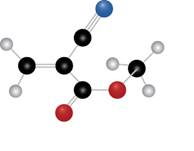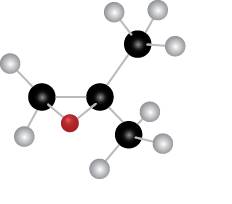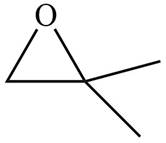
(a)
Interpretation: The structure of the polymer formed by chain-growth
Concept introduction: The simpler units which combine to form
Answer to Problem 24P
The structure of the polymer formed by chain-growth polymerization of given monomer is,

Explanation of Solution
The given molecule is

Figure 1
The blue coloured ball has three bonds. So, this is the nitrogen atom. The red coloured ball has two bonds. So, this is the oxygen atom. The black coloured atoms have four bonds. So, these are the carbon atoms. The grey coloured balls have one bond. So, these are the hydrogen atoms. The molecular structure of the compound is,

Figure 2
Chain-growth polymerization is formed by the repetitive addition of monomer units containing double or triple bonds. If the monomer units undergoing addition are the same, the polymer is known as
The polymer formed by chain-growth polymerization of given monomer is shown below.

Figure 3
The structure of the polymer formed by chain-growth polymerization of given monomer is shown in Figure 3.
(b)
Interpretation: The structure of the polymer formed by chain-growth polymerization of given monomer is to be drawn.
Concept introduction: The simpler units which combine to form polymers are known as monomers. The process by which respective monomers combine to form polymers is known as polymerization.
Answer to Problem 24P
The structure of the polymer formed by chain-growth polymerization of given monomer is,

Explanation of Solution
The given molecule is

Figure 4
The red coloured ball has two bonds. So, this is the oxygen atom. The black coloured atoms have four bonds. So, these are the carbon atoms. The grey coloured balls have one bond. So, these are the hydrogen atoms. The molecular structure of the compound is,

Figure 5
Chain-growth polymerization is formed by the repetitive addition of monomer units containing double or triple bonds. If the monomer units undergoing addition are the same, the polymer is known as homopolymer.
The polymer formed by chain-growth polymerization of given monomer is shown below.

Figure 6
The structure of the polymer formed by chain-growth polymerization of given monomer is shown in Figure 6.
Want to see more full solutions like this?
Chapter 28 Solutions
ORGANIC CHEMISTRY (LL+SM+ACCESS)

 Introductory Chemistry: An Active Learning Approa...ChemistryISBN:9781305079250Author:Mark S. Cracolice, Ed PetersPublisher:Cengage Learning
Introductory Chemistry: An Active Learning Approa...ChemistryISBN:9781305079250Author:Mark S. Cracolice, Ed PetersPublisher:Cengage Learning Chemistry: Principles and PracticeChemistryISBN:9780534420123Author:Daniel L. Reger, Scott R. Goode, David W. Ball, Edward MercerPublisher:Cengage Learning
Chemistry: Principles and PracticeChemistryISBN:9780534420123Author:Daniel L. Reger, Scott R. Goode, David W. Ball, Edward MercerPublisher:Cengage Learning Chemistry: An Atoms First ApproachChemistryISBN:9781305079243Author:Steven S. Zumdahl, Susan A. ZumdahlPublisher:Cengage Learning
Chemistry: An Atoms First ApproachChemistryISBN:9781305079243Author:Steven S. Zumdahl, Susan A. ZumdahlPublisher:Cengage Learning
 ChemistryChemistryISBN:9781305957404Author:Steven S. Zumdahl, Susan A. Zumdahl, Donald J. DeCostePublisher:Cengage Learning
ChemistryChemistryISBN:9781305957404Author:Steven S. Zumdahl, Susan A. Zumdahl, Donald J. DeCostePublisher:Cengage Learning





